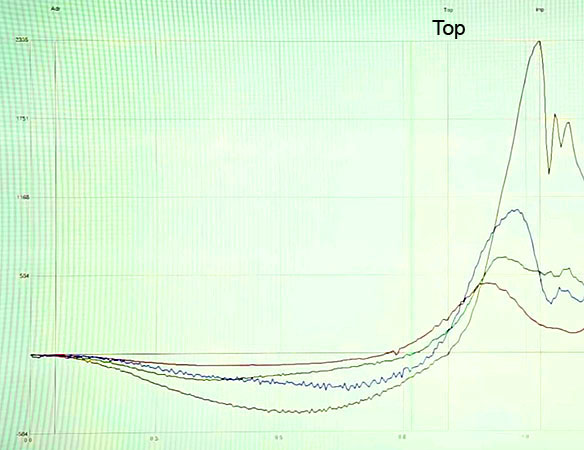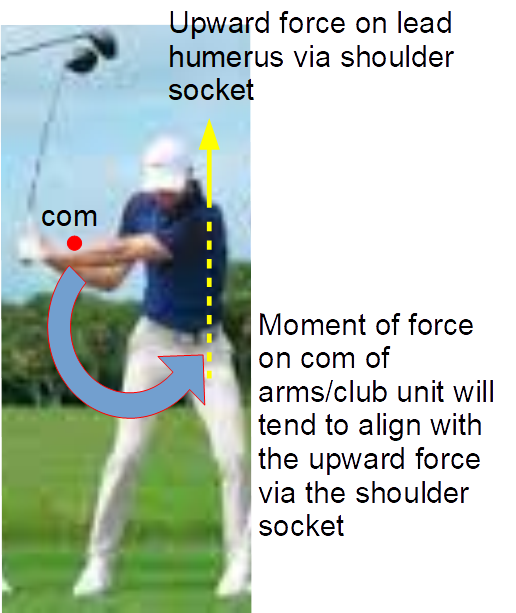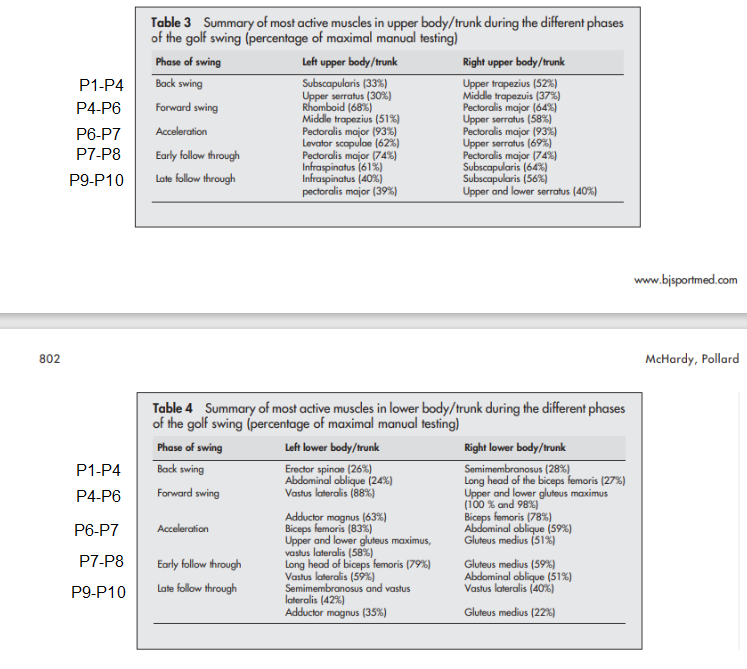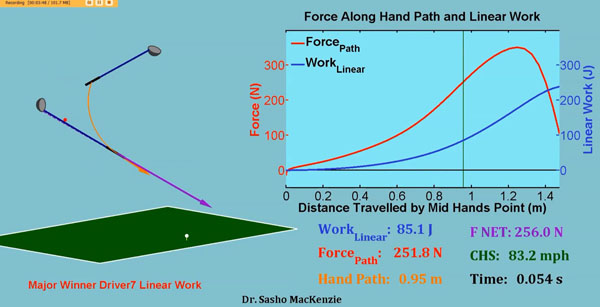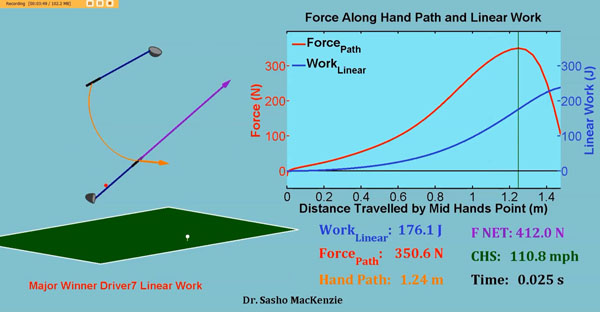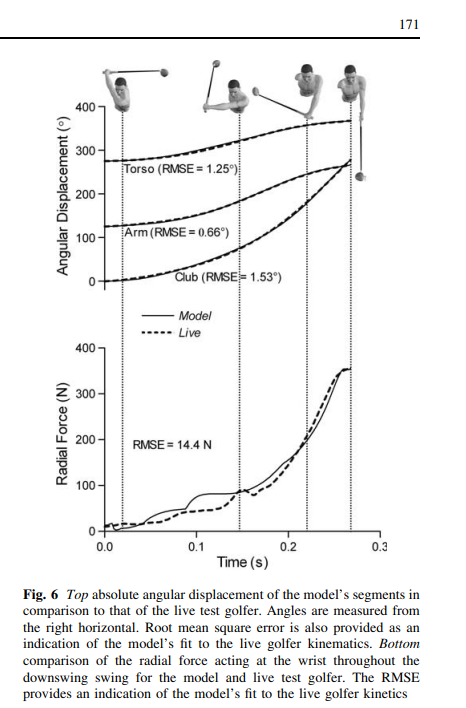Post by imperfectgolfer on Feb 24, 2023 10:39:40 GMT -5
In a series of posts I am going to analyse the following controversial AMG video.
This is an interesting video that has garnered a lot of commentary in different golf forums.
For example, the GolfWRX thread on this topic - forums.golfwrx.com/topic/1915874-new-amg-shallowing-video-wow/ - is already on page 67.
I will be expressing my personal opinions in part 1 of this post and I will be providing even more commentary in subsequent posts.
Part 1-:
The AMG commentary starts in earnest at the 1:15 minute time point of their video when the AMG video show a clip of Milo Lines (ML) demonstrating that the lead arm adducts more at the start of the transition. Mike Granato (MG) then defines his AMG definition of the term "transition" as being the time period between when the pelvis first starts to rotate counterclockwise and the P4 position (when the club first starts to move in the opposite direction). I can understand why MG uses the term "transition" in that descriptive manner, but many other golf instructors describe the transition to the downswing as starting from the exact moment that the club starts to change direction. I personally do not think that this distinction is particularly relevant in this discussion of the "arm lowering" phenomenon because the focus of MG's attention is going to be on the arm motion relative to the upper body (and not the pelvis).
MG agrees that the lead arm may adduct momentarily, and that the trail elbow may bend more momentarily, at the start of the transition in a pro golfer because the arms/club have inertia. This phase is very short-lived in a pro golfer and it has no real significance when considering the overall arm lowering phenomenon that happens between P4 => P5.5.
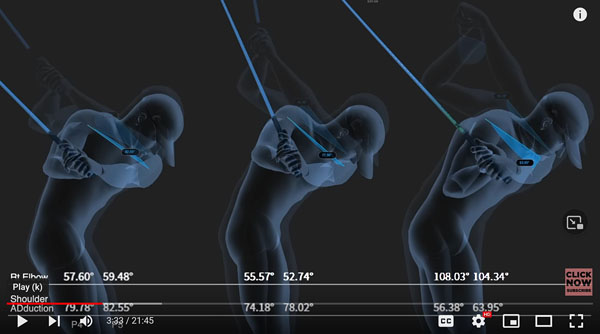

www.instagram.com/reel/ConeFEdg4CN/?igshid=YmMyMTA2M2Y=
www.instagram.com/reel/CooEwEkjTIG/?igshid=YmMyMTA2M2Y=
Here are capture images from one of George Gankas' instagram videos.
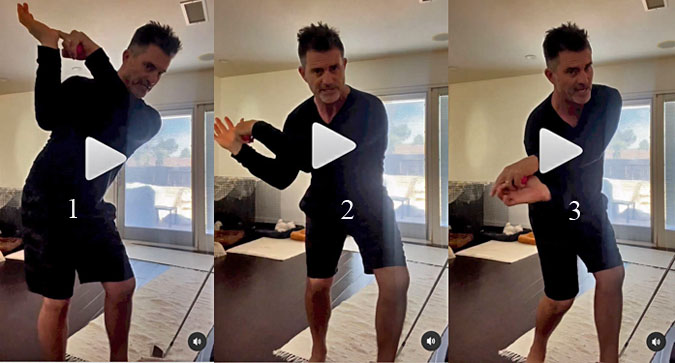

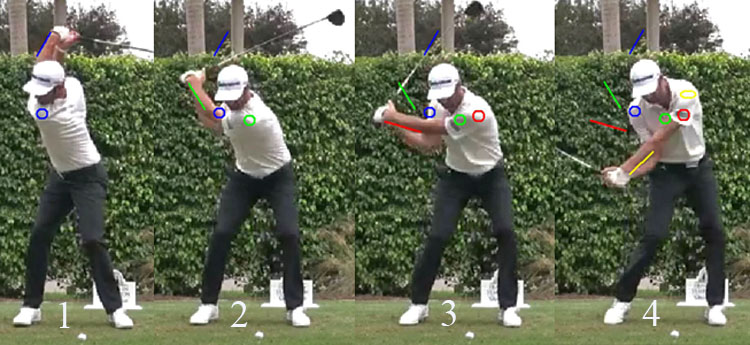
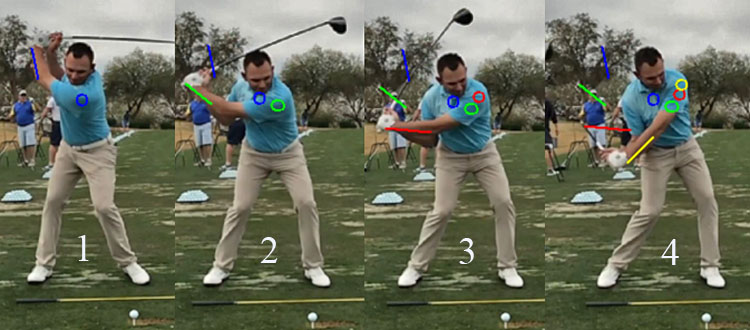
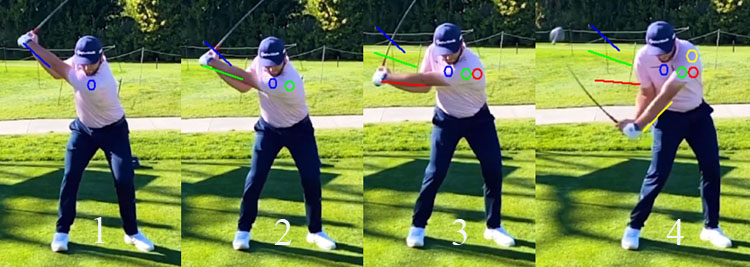
In summary, I think that these 3 pro golfers use basically the same ACTIVE pivot-induced release of PA#4 swing technique to get their lead arm to reach its maximum speed by ~P5.5 and I believe that the "lead arm lowering" phenomenon that happens between P4 => P5.5 is not a passive "arm dropping" or a passive "arm carrying" phenomenon.
Now, I will discuss the role of the trail arm during the pivot-induced release of PA#4 (release of the lead arm) in a pro-quality driver golf swing action.
First of all, a golfer should not think that the trail arm should be primarily used to increase the speed of the pivot-induced release of PA#4 by harboring the wrongheaded "idea" that the primary function of the trail arm/hand is to make the lead arm/hand move faster between P4 => P5.5. Rather, the basic "idea" should be to make sure that the trail hand moves as fast as the lead hand between P4 => P5.5 so that it does not impede the efficient pivot-induced release of the lead arm. More importantly, the primary thought should not be focused on simply moving the trail hand as fast as the lead hand between P4 => P5.5 (which has to happen in an efficient release of PA#4), but the primary thought should be focused on using the trail arm/hand in such a manner that it can potentially help to increase the efficiency and speed of release of PA#2 (release of the club) that happens between P5.5 => P7. I think that a golfer can increase the efficient release of PA#2 by using the trail arm/hand to i) help a golfer avoid casting and help him to maintain a high degree of clubhead lag until ~P5.5; and ii) help him to shape the hand arc path so that it is more U-shaped between P4 => P5.5.
If you look at the trail arm's motion in DJ's, ML's and JR's early-mid downswing action between P4 => P5.5, they all have the same pattern of trail arm motion. Note that they all have a bent trail elbow at their P4 position and that they only partially straighten their trail elbow to a small degree between P4 => P5.5. Also, note that they lead with their trail elbow using a pitch elbow motion of their trail arm (note how their trail elbow is positioned below their lead elbow at their P5 position when viewed from a face-on viewing perspective) and that they all get their trail elbow down to waist level by P5.5 where the trail elbow is positioned slightly in front of the trail hip joint area, or positioned alongside their trail shirt seam, at P5.5. Their speed of trail upper arm adduction may differ slightly, and their degree of trail elbow straightening may differ slightly, but they all can maintain a clubhead lag angle of ~90 degrees at P5.5 and they all avoid casting during their early-mid downswing action. That would not be possible if they prematurely straightened their trail arm to an excessive degree between P4 => P5.5.
Another major factor that they all have in common is the position of their trail hand at P5.5. Note that they all have their trail hand positioned about ~12" outside the outer border of their trail thigh at their P5.5 position when their trail hand is at waist level, or slightly below waist level. I think that it is extremely useful to those 3 pro golfers to move their trail arm/forearm in such a manner that their trail hand is positioned as described at ~P5.5 because it will shape their hand arc path to be more U-shaped during their mid-downswing time period.
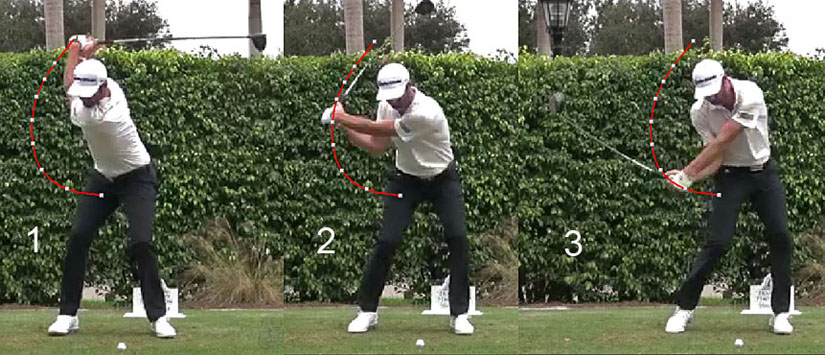
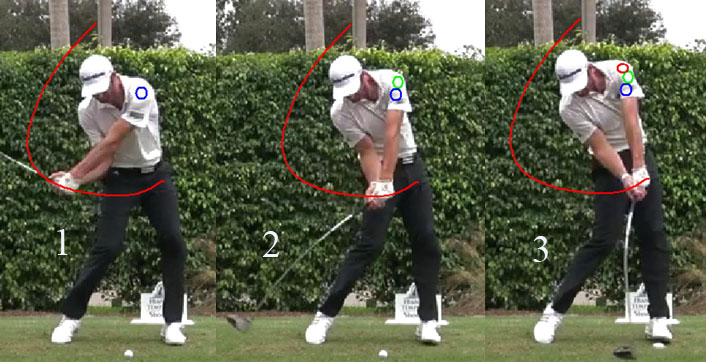
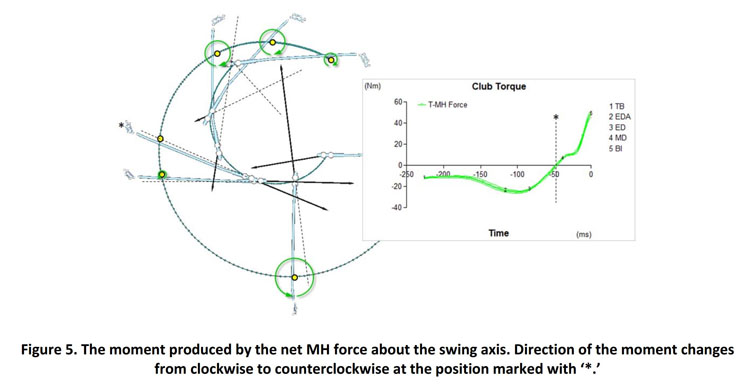

The red splined path is his hand arc path.
Note how much JS is lowering his lead arm between P4 => P5.5 as a result of his pivot-induced release of PA#4 (release of his lead arm).
Most importantly, note that he is not shallowing his clubshaft between P4 => P5.5 and his clubshaft is simply coming down the TSP (turned shoulder plane) without shallowing to a shallower plane (eg. elbow plane or hand plane) and also without shallowing relative to his hand arc path.
It is not obligatory to shallow the clubshaft during the "arm lowering" action that happens between P4 => P5.5 and it is an optional choice. Many pro golfers choose to shallow their clubshaft during the P4 => P5.5 time period and the question that arises is how do they achieve that goal from a biomechanical perspective in a two-armed golf swing action?
I think that the trail arm plays the dominant role in the execution of a clubshaft shallowing action and that there are two different biomechanical mechanisms in play. The first biomechanical mechanism is in play between P4 => P5, and the 2nd biomechanical mechanism is in play between P5 => P5.5.
I will use Milo Lines' driver golf swing action as an example.
![]()

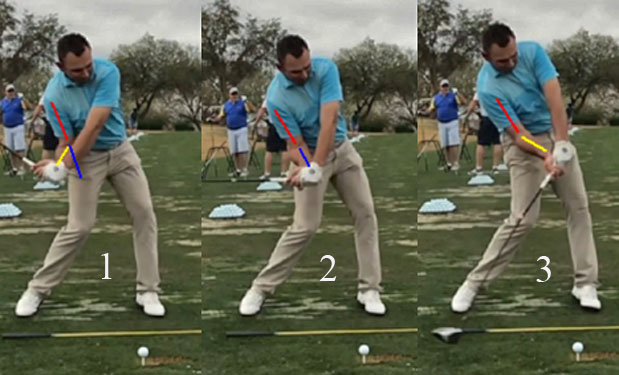
This is an interesting video that has garnered a lot of commentary in different golf forums.
For example, the GolfWRX thread on this topic - forums.golfwrx.com/topic/1915874-new-amg-shallowing-video-wow/ - is already on page 67.
I will be expressing my personal opinions in part 1 of this post and I will be providing even more commentary in subsequent posts.
Part 1-:
The AMG commentary starts in earnest at the 1:15 minute time point of their video when the AMG video show a clip of Milo Lines (ML) demonstrating that the lead arm adducts more at the start of the transition. Mike Granato (MG) then defines his AMG definition of the term "transition" as being the time period between when the pelvis first starts to rotate counterclockwise and the P4 position (when the club first starts to move in the opposite direction). I can understand why MG uses the term "transition" in that descriptive manner, but many other golf instructors describe the transition to the downswing as starting from the exact moment that the club starts to change direction. I personally do not think that this distinction is particularly relevant in this discussion of the "arm lowering" phenomenon because the focus of MG's attention is going to be on the arm motion relative to the upper body (and not the pelvis).
MG agrees that the lead arm may adduct momentarily, and that the trail elbow may bend more momentarily, at the start of the transition in a pro golfer because the arms/club have inertia. This phase is very short-lived in a pro golfer and it has no real significance when considering the overall arm lowering phenomenon that happens between P4 => P5.5.
MG then shows what happens between P4 => P5 in three pro golfers - Sergio Garcia, Rory Mclroy and Dustin Johnson - in the following capture image from the 3:33 minute time point of their video.

They provide data on the changes in the amount of i) trail elbow bend angle measurement and ii) the lead shoulder abduction measurement that happen between P4 => P5.
I am not really interested in those specific measurements when it comes to exploring the topic of the "arm lowering" phenomenon that happens in the early downswing, and I am really interested in quantifying the amount of "arm lowering" seen in that image at P5 (compared to the shadow image seen in the background that represents the positional alignment of the upper body and arms at P4) and I am really interesting in what is causing those "arm lowering" changes.
Here is a capture image of those 3 pro golfers at their P6 position.
I am not really interested in those specific measurements when it comes to exploring the topic of the "arm lowering" phenomenon that happens in the early downswing, and I am really interested in quantifying the amount of "arm lowering" seen in that image at P5 (compared to the shadow image seen in the background that represents the positional alignment of the upper body and arms at P4) and I am really interesting in what is causing those "arm lowering" changes.
Here is a capture image of those 3 pro golfers at their P6 position.

Again, you can see the change in their degree of trail ebow bend and lead arm abduction measurements that is happening between P5 => P6.
From my personal perspective, as I have previously stated, I am not primarily interested in those trail elbow bend angle/lead arm abduction measurements, and I am mainly interested in the degree of "arm lowering" that is happening between P4 => P5.5 and I am particularly interested in what is causing the "arm lowering" phenomenon during the early-mid downswing time period.
MG analyses what Milo claims causes the "arm lowering" phenomenon during the early downswing between P4 => P5 - where Milo claims that it happens because he bounces from left side-bend to right side-bend. MG correctly demonstrates that Milo is wrong to state that he is in a condition of maximum right side-bend at P5, and he clearly shows that Milo's rib cage side-bend measurement still shows left side-bend at P5. In other words, there is no evidence that Milo, or any of those 3 pro golfers, are significantly side-bending their rib cage (thorax) to the right between P4 => P5 and therefore increasingly compressing the right side of their rib cage. More importantly, what effect would Milo's concept of "bouncing from left side-bend to right side-bend" have with respect to the "arm lowering" phenomenon. Milo seemingly implies that the "arm lowering" phenomenon that happens between P4 => P5 is not due to an independent arm motion, and that the arms are basically being "carried-down" to a lower position by the rotating upper torso. Amazingly, Mike Granato does not delve deeper into this "arm lowering" issue and he does not discuss what is causing the "arm lowering" phenomenon that happens between P4 => P5, and which becomes even greater in degree between P5 => P5.5.
In online golf forums and in instagram posts, golfers and golf instructors have pontificated on this "arm lowering" phenomenon, and some of their comments are hilariously incomplete or wrongheaded - as can be seen in these instagram posts by Brian Manzella and George Gankas.
From my personal perspective, as I have previously stated, I am not primarily interested in those trail elbow bend angle/lead arm abduction measurements, and I am mainly interested in the degree of "arm lowering" that is happening between P4 => P5.5 and I am particularly interested in what is causing the "arm lowering" phenomenon during the early-mid downswing time period.
MG analyses what Milo claims causes the "arm lowering" phenomenon during the early downswing between P4 => P5 - where Milo claims that it happens because he bounces from left side-bend to right side-bend. MG correctly demonstrates that Milo is wrong to state that he is in a condition of maximum right side-bend at P5, and he clearly shows that Milo's rib cage side-bend measurement still shows left side-bend at P5. In other words, there is no evidence that Milo, or any of those 3 pro golfers, are significantly side-bending their rib cage (thorax) to the right between P4 => P5 and therefore increasingly compressing the right side of their rib cage. More importantly, what effect would Milo's concept of "bouncing from left side-bend to right side-bend" have with respect to the "arm lowering" phenomenon. Milo seemingly implies that the "arm lowering" phenomenon that happens between P4 => P5 is not due to an independent arm motion, and that the arms are basically being "carried-down" to a lower position by the rotating upper torso. Amazingly, Mike Granato does not delve deeper into this "arm lowering" issue and he does not discuss what is causing the "arm lowering" phenomenon that happens between P4 => P5, and which becomes even greater in degree between P5 => P5.5.
In online golf forums and in instagram posts, golfers and golf instructors have pontificated on this "arm lowering" phenomenon, and some of their comments are hilariously incomplete or wrongheaded - as can be seen in these instagram posts by Brian Manzella and George Gankas.
www.instagram.com/reel/CoioxakAboV/?igshid=YmMyMTA2M2Y=
www.instagram.com/reel/CoktMsouE5S/?igshid=YmMyMTA2M2Y=
www.instagram.com/reel/CoktMsouE5S/?igshid=YmMyMTA2M2Y=
www.instagram.com/reel/ConeFEdg4CN/?igshid=YmMyMTA2M2Y=
www.instagram.com/reel/CooEwEkjTIG/?igshid=YmMyMTA2M2Y=
Here are capture images from one of George Gankas' instagram videos.

Image 1 is at a simulated P4 position where his lead arm is adducted across his chest and where his trail upper arm is abducted. He likes to start off with his trail upper arm externally rotated to a small degree, but most pro golfers' trail upper arms are probably neutral at P4.
Image 2 is at a simulated P5 position and he is squating and completing his hip-squaring phase. Note that he keeps his lead upper arm adducted to the same degree and he is not actively adducting his trail upper arm towards his trail side shirt seam. He is seemingly "carrying" his arms down from P4 => P5 and he does not seem to be accelerating his lead arm actively between P4 => P5.
Image 3 is at P5.5. Note that he still has his lead arm fully adducted at P5.5 with his hands at waist level.
From that P5.5 position, GG talks of catapulting his lead arm away from his chest - presumably via a rotary pivot motion involving a fast motion of his lead shoulder socket. That would cause the lead arm to move very fast in a targetwards direction between P5.5 => P7 and I don't know how he could succeed in completing the release of PA#2 by impact by using that very late lead arm acceleration technique.
I think that George's opinions regarding the "arm lowering" action are nonsensical and I think that Brian Manzella correctly shows how the trail elbow moves down to a pitch location alongside the trail hip area by P6, but Brian does not explain what causes the "arm lowering" phenomenon that happens between P4 => P6. That is the fundamental issue that needs a biomechanically rational explanantion. Ben Hogan in his golf instructional book implied that the "arms get a free ride" from the P4 position to the P6 position if one starts the kinematic sequence with a pelvic shift-rotation movement, but he did not explain how that can possibly happen in such a passive manner. Some golf instructors also talk very vaguely about a passive "arm dropping" phenomenon, but I cannot envisage how the "arm lowering" phenomenon can be deemed to be passive. 3-D kinematic studies have shown that the "average" pro golfer's lead arm reaches its maximum speed at ~P5.5 in their driver golf swing action, and I cannot fathom why golfers would believe that this accomplishment can be achieved via some passive "arm lowering" phenomenon.
I have a very different perspective on what causes the "arm lowering" phenomenon between P4 => P5.5 in the driver golf swings of pro golfers and I will now be expressing my opinions on this topic.
I believe that most pro golfers use a pivot-induced TGM swinging action (lead arm swinging action) to power their driver golf swing action - as can be seen in the following video showing how Logan Aldridge (lead arm-only golfer) drives the ball >300 yards.
Image 2 is at a simulated P5 position and he is squating and completing his hip-squaring phase. Note that he keeps his lead upper arm adducted to the same degree and he is not actively adducting his trail upper arm towards his trail side shirt seam. He is seemingly "carrying" his arms down from P4 => P5 and he does not seem to be accelerating his lead arm actively between P4 => P5.
Image 3 is at P5.5. Note that he still has his lead arm fully adducted at P5.5 with his hands at waist level.
From that P5.5 position, GG talks of catapulting his lead arm away from his chest - presumably via a rotary pivot motion involving a fast motion of his lead shoulder socket. That would cause the lead arm to move very fast in a targetwards direction between P5.5 => P7 and I don't know how he could succeed in completing the release of PA#2 by impact by using that very late lead arm acceleration technique.
I think that George's opinions regarding the "arm lowering" action are nonsensical and I think that Brian Manzella correctly shows how the trail elbow moves down to a pitch location alongside the trail hip area by P6, but Brian does not explain what causes the "arm lowering" phenomenon that happens between P4 => P6. That is the fundamental issue that needs a biomechanically rational explanantion. Ben Hogan in his golf instructional book implied that the "arms get a free ride" from the P4 position to the P6 position if one starts the kinematic sequence with a pelvic shift-rotation movement, but he did not explain how that can possibly happen in such a passive manner. Some golf instructors also talk very vaguely about a passive "arm dropping" phenomenon, but I cannot envisage how the "arm lowering" phenomenon can be deemed to be passive. 3-D kinematic studies have shown that the "average" pro golfer's lead arm reaches its maximum speed at ~P5.5 in their driver golf swing action, and I cannot fathom why golfers would believe that this accomplishment can be achieved via some passive "arm lowering" phenomenon.
I have a very different perspective on what causes the "arm lowering" phenomenon between P4 => P5.5 in the driver golf swings of pro golfers and I will now be expressing my opinions on this topic.
I believe that most pro golfers use a pivot-induced TGM swinging action (lead arm swinging action) to power their driver golf swing action - as can be seen in the following video showing how Logan Aldridge (lead arm-only golfer) drives the ball >300 yards.
Here are capture images of his P4 => P6 early-mid downswing action.

Image 1 is at P4, image 2 is at P5, image 3 is at P5.5 and image 4 is at P6.
Note that his lead arm is lowering between P4 => P6.
What is causing that arm lowering phenomenon? I believe that it primarily due to the fact that he is performing a pivot-induced release of his lead arm (= release of PA#4 in TGM terminology where the term "PA" is an abbreviation of the term "power accumulator") in such a manner that his lead arm's angular speed reaches its maximum speed at ~P5.5 (image 3).
How does a pro golfer perform his pivot motion so that he can efficiently release his lead arm so that his lead arm's speed reaches its maximum value by ~P5.5?
I will start off by discussing how I think that Dustin Johnson releases his PA#4 (lead arm) using a pivot-induced release of PA#4.
Note that his lead arm is lowering between P4 => P6.
What is causing that arm lowering phenomenon? I believe that it primarily due to the fact that he is performing a pivot-induced release of his lead arm (= release of PA#4 in TGM terminology where the term "PA" is an abbreviation of the term "power accumulator") in such a manner that his lead arm's angular speed reaches its maximum speed at ~P5.5 (image 3).
How does a pro golfer perform his pivot motion so that he can efficiently release his lead arm so that his lead arm's speed reaches its maximum value by ~P5.5?
I will start off by discussing how I think that Dustin Johnson releases his PA#4 (lead arm) using a pivot-induced release of PA#4.

Image 1 is his P4 position, image 2 is at his P4.5 position, image 3 is at his P5 position and image 4 is at his P5.5 position.
Note that I have drawn a blue circular marker over his lead shoulder socket at his P4 position and I have drawn a short blue line alongside the ulnar side of his lead lower forearm at his P4 position.
Note that I have drawn a green circular marker over his lead shoulder socket at his P4.5 position and I have drawn a short green line alongside the ulnar side of his lead lower forearm at his P4.5 position.
By comparing the position of that green line to the blue line, one can get a good visual impression of how much his lead arm is lowering between P4 => P4.5.
What is causing that lead arm lowering action between P4 => P4.5?
I believe that it is secondary to the pivot motion happening during that P4 => P4.5 time period. DJ starts his downswing action with a pelvic shift-rotation movement that is followed momentarily later by a counterclockwise rotation of his upper torso with a finite degree of torso-pelvic separation (dynamic X-factor). When the upper torso rotates counterclockwise, the lead shoulder socket moves targetwards - note that DJ's lead shoulder socket moves targetwards by ~8" between P4 => P4.5. The targetwards motion of his left shoulder socket obviously pulls the head of the lead humerus along thereby causing a motion of the lead arm. Because the lead arm is angled near-vertically at the ~12 o'clock position at P4, the pull exerted by the targetwards motion of the lead shoulder socket will pull the lead arm mainly downwards. I strongly suspect that DJ's lead shoulder girdle muscles are also actively contracting thereby helping him to direct the lead arm's motion in a more downwards direction. Note that DJ's lead arm remains adducted to roughly the same degree at P4.5 (compared to P4) giving an observer the false impression that the lead arm is being "carried" along by the lead shoulder socket. However, I believe that this is a false impression. I strongly suspect that once DJ starts to rotate his upper torso counterclockwise that he is doing it at a very fast speed and that the lead arm is already being catapulted (released) away from its adducted position. However, the lead arm/clubshaft have an inherent inertia that needs to be overcome before the lead arm can be visually determined to be traveling faster than the upper torso, and that may not be visually apparent between P4 => P4.5.
Note how much his lead shoulder socket is moving in a targtewards direction between P4.5 => P5 (see red circular maker compared to the green circular marker). One can now clearly see that his lead arm is traveling faster than the upper torso and that the lead arm is moving towards more abduction. MG provided substantial data from his GEARS measurements in his video showing that DJ's lead arm is accelerating a lot between P4.5 => P5.
Note how much DJ's lead arm has moved downwards between P5 => P5.5 (see short yellow line compared to the short red line) even though the lead shoulder socket is not continuing to move targetwards and it is now starting to move mainly upwards (see yellow circular maker compared to the red circular marker). Even though the downwards-directed pull of the lead arm happening via the mechanism of the targetwards-directed motion of the lead shoulder socket is diminishing between P5 => P5.5, the lead arm is still actually accelerating between P5 => P5.5 and it only reaches its maximum speed by P5.5. One needs to think of the lead shoulder socket's motion between P4 => P5.5 as being a very fast continuous motion that catapults (releases) the lead arm with a high degree of force so that the lead arm reaches its maximum speed at ~P5.5 - and this represents the TGM concept of a pivot-induced release of PA#4 (release of the lead arm).
Now, let's consider Milo Lines' pivot-induced PA#4 release action (compared to DJ's pivot-induced PA#4 release action).
Note that I have drawn a blue circular marker over his lead shoulder socket at his P4 position and I have drawn a short blue line alongside the ulnar side of his lead lower forearm at his P4 position.
Note that I have drawn a green circular marker over his lead shoulder socket at his P4.5 position and I have drawn a short green line alongside the ulnar side of his lead lower forearm at his P4.5 position.
By comparing the position of that green line to the blue line, one can get a good visual impression of how much his lead arm is lowering between P4 => P4.5.
What is causing that lead arm lowering action between P4 => P4.5?
I believe that it is secondary to the pivot motion happening during that P4 => P4.5 time period. DJ starts his downswing action with a pelvic shift-rotation movement that is followed momentarily later by a counterclockwise rotation of his upper torso with a finite degree of torso-pelvic separation (dynamic X-factor). When the upper torso rotates counterclockwise, the lead shoulder socket moves targetwards - note that DJ's lead shoulder socket moves targetwards by ~8" between P4 => P4.5. The targetwards motion of his left shoulder socket obviously pulls the head of the lead humerus along thereby causing a motion of the lead arm. Because the lead arm is angled near-vertically at the ~12 o'clock position at P4, the pull exerted by the targetwards motion of the lead shoulder socket will pull the lead arm mainly downwards. I strongly suspect that DJ's lead shoulder girdle muscles are also actively contracting thereby helping him to direct the lead arm's motion in a more downwards direction. Note that DJ's lead arm remains adducted to roughly the same degree at P4.5 (compared to P4) giving an observer the false impression that the lead arm is being "carried" along by the lead shoulder socket. However, I believe that this is a false impression. I strongly suspect that once DJ starts to rotate his upper torso counterclockwise that he is doing it at a very fast speed and that the lead arm is already being catapulted (released) away from its adducted position. However, the lead arm/clubshaft have an inherent inertia that needs to be overcome before the lead arm can be visually determined to be traveling faster than the upper torso, and that may not be visually apparent between P4 => P4.5.
Note how much his lead shoulder socket is moving in a targtewards direction between P4.5 => P5 (see red circular maker compared to the green circular marker). One can now clearly see that his lead arm is traveling faster than the upper torso and that the lead arm is moving towards more abduction. MG provided substantial data from his GEARS measurements in his video showing that DJ's lead arm is accelerating a lot between P4.5 => P5.
Note how much DJ's lead arm has moved downwards between P5 => P5.5 (see short yellow line compared to the short red line) even though the lead shoulder socket is not continuing to move targetwards and it is now starting to move mainly upwards (see yellow circular maker compared to the red circular marker). Even though the downwards-directed pull of the lead arm happening via the mechanism of the targetwards-directed motion of the lead shoulder socket is diminishing between P5 => P5.5, the lead arm is still actually accelerating between P5 => P5.5 and it only reaches its maximum speed by P5.5. One needs to think of the lead shoulder socket's motion between P4 => P5.5 as being a very fast continuous motion that catapults (releases) the lead arm with a high degree of force so that the lead arm reaches its maximum speed at ~P5.5 - and this represents the TGM concept of a pivot-induced release of PA#4 (release of the lead arm).
Now, let's consider Milo Lines' pivot-induced PA#4 release action (compared to DJ's pivot-induced PA#4 release action).

Image 1 is at P4, image 2 is at P4.5, image 3 is at P5 and image 4 is at P5.5.
Note that ML's lead shoulder socket only moves targetwards for ~6" between P4 => P4.5 and it then starts to move slightly upwards. That means that he has significantly less lead shoulder socket travel distance in a targetwards direction (compared to DJ) happening during his PA#4 release phase that is happening between P4 => P5.5, but he can apparently release PA#4 as fast as DJ. How is that possible? I think that the most rational answer is that ML can move his lead shoulder socket faster than DJ between P4 => P5 as a result of a faster upper torso rotation and that he can also catapult the lead arm faster in a more downwards direction. ML uses a very rotary pivot motion that is very efficient and superfast and that likely allows him to release PA#4 as fast as pro golfers like Dustin Johnson and Jon Rahm.
Here are capture images showing Jon Rahm's pivot-induced release of PA#4.
Note that ML's lead shoulder socket only moves targetwards for ~6" between P4 => P4.5 and it then starts to move slightly upwards. That means that he has significantly less lead shoulder socket travel distance in a targetwards direction (compared to DJ) happening during his PA#4 release phase that is happening between P4 => P5.5, but he can apparently release PA#4 as fast as DJ. How is that possible? I think that the most rational answer is that ML can move his lead shoulder socket faster than DJ between P4 => P5 as a result of a faster upper torso rotation and that he can also catapult the lead arm faster in a more downwards direction. ML uses a very rotary pivot motion that is very efficient and superfast and that likely allows him to release PA#4 as fast as pro golfers like Dustin Johnson and Jon Rahm.
Here are capture images showing Jon Rahm's pivot-induced release of PA#4.

Image 1 is at P4, image 2 is at P4.5, image 3 is at P5 and image 4 is at P5.5.
Note that JR's lead arm is angled at the 10 o'clock position at P4. That means that his degree of lead arm lowering travel distance between P4 => P5.5 is going to be less than DJs. However, he likely releases PA#4 as fast as DJ with his lead arm reaching its maximum speed at ~P5.5 due to the fact that he rotates his upper torso faster than DJ (and in a similarly efficient manner compared to ML) and because he catapults his lead arm faster downwards than DJ.
Note that JR's lead arm is angled at the 10 o'clock position at P4. That means that his degree of lead arm lowering travel distance between P4 => P5.5 is going to be less than DJs. However, he likely releases PA#4 as fast as DJ with his lead arm reaching its maximum speed at ~P5.5 due to the fact that he rotates his upper torso faster than DJ (and in a similarly efficient manner compared to ML) and because he catapults his lead arm faster downwards than DJ.
Sasho MacKenzie stated at a conference that a golfer can achieve the maximum speed of the lead hand down the hand arc path from P4 => P5.5 via two elements - i) by increasing the length of the hand arc path between P4 => P5.5 or ii) by increasing the "average" speed of the lead hand motion over the length of the hand arc path. If Milo Lines and Jon Rahm can achieve the same lead hand speed at P5.5 as Dustin Johnson (who has a much longer hand arc path) then it implies that they can biomechanically increase the "average" speed of the lead hand down the hand arc path between P4 => P5.5.
In summary, I think that these 3 pro golfers use basically the same ACTIVE pivot-induced release of PA#4 swing technique to get their lead arm to reach its maximum speed by ~P5.5 and I believe that the "lead arm lowering" phenomenon that happens between P4 => P5.5 is not a passive "arm dropping" or a passive "arm carrying" phenomenon.
Now, I will discuss the role of the trail arm during the pivot-induced release of PA#4 (release of the lead arm) in a pro-quality driver golf swing action.
First of all, a golfer should not think that the trail arm should be primarily used to increase the speed of the pivot-induced release of PA#4 by harboring the wrongheaded "idea" that the primary function of the trail arm/hand is to make the lead arm/hand move faster between P4 => P5.5. Rather, the basic "idea" should be to make sure that the trail hand moves as fast as the lead hand between P4 => P5.5 so that it does not impede the efficient pivot-induced release of the lead arm. More importantly, the primary thought should not be focused on simply moving the trail hand as fast as the lead hand between P4 => P5.5 (which has to happen in an efficient release of PA#4), but the primary thought should be focused on using the trail arm/hand in such a manner that it can potentially help to increase the efficiency and speed of release of PA#2 (release of the club) that happens between P5.5 => P7. I think that a golfer can increase the efficient release of PA#2 by using the trail arm/hand to i) help a golfer avoid casting and help him to maintain a high degree of clubhead lag until ~P5.5; and ii) help him to shape the hand arc path so that it is more U-shaped between P4 => P5.5.
If you look at the trail arm's motion in DJ's, ML's and JR's early-mid downswing action between P4 => P5.5, they all have the same pattern of trail arm motion. Note that they all have a bent trail elbow at their P4 position and that they only partially straighten their trail elbow to a small degree between P4 => P5.5. Also, note that they lead with their trail elbow using a pitch elbow motion of their trail arm (note how their trail elbow is positioned below their lead elbow at their P5 position when viewed from a face-on viewing perspective) and that they all get their trail elbow down to waist level by P5.5 where the trail elbow is positioned slightly in front of the trail hip joint area, or positioned alongside their trail shirt seam, at P5.5. Their speed of trail upper arm adduction may differ slightly, and their degree of trail elbow straightening may differ slightly, but they all can maintain a clubhead lag angle of ~90 degrees at P5.5 and they all avoid casting during their early-mid downswing action. That would not be possible if they prematurely straightened their trail arm to an excessive degree between P4 => P5.5.
Another major factor that they all have in common is the position of their trail hand at P5.5. Note that they all have their trail hand positioned about ~12" outside the outer border of their trail thigh at their P5.5 position when their trail hand is at waist level, or slightly below waist level. I think that it is extremely useful to those 3 pro golfers to move their trail arm/forearm in such a manner that their trail hand is positioned as described at ~P5.5 because it will shape their hand arc path to be more U-shaped during their mid-downswing time period.
Here are capture images showing Dustin Johnson's hand arc path.

Image 1 is at P4, image 2 is at P5 and image 3 is at P5.5.
The red splined path shows his hand arc path between P4 => P5.5.
Note that DJ's hands are lowering a lot between P4 => P5.5 due to his pivot-induced release of PA#4 (which is causally responsible for the "lead arm lowering" phenomenon), but note that his two hands are located ~12" outside the outer border of his trail thigh at his P5.5 position and that his lead hand is no closer to the target at P5.5 than it was at P4.
What makes it biomechanically possible for DJ to successfully position his hands ~12" outside his trail thigh at P5.5 is the specific way that he moves his trail arm/forearm between P4 => P5.5.
Note that DJ is actively adducting his trail upper arm between P4 => P5 using a pitch elbow motion of his trail arm where his trail elbow leads his trail hand - note how his trail elbow is visible well below his lead elbow at P5. Note that he has not yet fully adducted his trail upper arm by P5 and that he continues to adduct his trail upper arm between P5 => P5.5 so that his trail upper arm gets angled towards the target by P5.5 with his trail elbow positioned in front of his trail hip joint area. Note that he has partially straightened his trail elbow and that his trail upper arm is externally rotated to a small degree, and that combination causes his trail forearm to be angled to the right (away from the target) so that his trail hand ends up being positioned below waist level and ~ 12" outside the outer border of his trail thigh.
Note that Milo Lines uses the same biomechanical actions as DJ, but Jon Rahm's trail arm motion is slightly different. Note that JR positions his trail elbow alongside his trail shirt seam at P5.5 and it is positioned higher than his trouser belt level. Note that his trail upper arm is not externally rotated at P5.5 and it is neutral. However, he still manages to angle his trail forearm to the right (in an away from the target direction) because his mid-upper torso is still closed relative to the ball-target line and his trail upper arm is neutrally aligned relative to his trail mid-torso's alignment. Note that JR's trail forearm slopes more vertically than DJ's trail forearm at P5.5, but he still also manages to position his trail hand ~12" outside the outer border of his trail thigh at P5.5 by having a greater degree of trail elbow straightening action.
What is the advantage of having the trail hand positioned well outside the trail thigh in a driver golf swing action?
Here are capture images of Dustin Johnson's late downswing action.
The red splined path shows his hand arc path between P4 => P5.5.
Note that DJ's hands are lowering a lot between P4 => P5.5 due to his pivot-induced release of PA#4 (which is causally responsible for the "lead arm lowering" phenomenon), but note that his two hands are located ~12" outside the outer border of his trail thigh at his P5.5 position and that his lead hand is no closer to the target at P5.5 than it was at P4.
What makes it biomechanically possible for DJ to successfully position his hands ~12" outside his trail thigh at P5.5 is the specific way that he moves his trail arm/forearm between P4 => P5.5.
Note that DJ is actively adducting his trail upper arm between P4 => P5 using a pitch elbow motion of his trail arm where his trail elbow leads his trail hand - note how his trail elbow is visible well below his lead elbow at P5. Note that he has not yet fully adducted his trail upper arm by P5 and that he continues to adduct his trail upper arm between P5 => P5.5 so that his trail upper arm gets angled towards the target by P5.5 with his trail elbow positioned in front of his trail hip joint area. Note that he has partially straightened his trail elbow and that his trail upper arm is externally rotated to a small degree, and that combination causes his trail forearm to be angled to the right (away from the target) so that his trail hand ends up being positioned below waist level and ~ 12" outside the outer border of his trail thigh.
Note that Milo Lines uses the same biomechanical actions as DJ, but Jon Rahm's trail arm motion is slightly different. Note that JR positions his trail elbow alongside his trail shirt seam at P5.5 and it is positioned higher than his trouser belt level. Note that his trail upper arm is not externally rotated at P5.5 and it is neutral. However, he still manages to angle his trail forearm to the right (in an away from the target direction) because his mid-upper torso is still closed relative to the ball-target line and his trail upper arm is neutrally aligned relative to his trail mid-torso's alignment. Note that JR's trail forearm slopes more vertically than DJ's trail forearm at P5.5, but he still also manages to position his trail hand ~12" outside the outer border of his trail thigh at P5.5 by having a greater degree of trail elbow straightening action.
What is the advantage of having the trail hand positioned well outside the trail thigh in a driver golf swing action?
Here are capture images of Dustin Johnson's late downswing action.

Image 1 is at P5.5, image 2 is at P6.5 and image 3 is at P7.
The red splined path is his hand arc path - note that DJ's hand arc path is relatively horizontal to the ground between P5.5 => P6.5 and that it then slopes upwards to a small degree between P6.5 => P7.
Note that I have drawn a small blue circular marker over his lead shoulder socket at P5.5, and a small green circular marker over his lead shoulder socket at P6.5, and a small red circular marker over his lead shoulder socket at P7. Note that his lead shoulder socket is basically moving vertically upwards between P5.5 => P7 and it is not moving targetwards, so any pulling force being exerted by the elevating lead shoulder socket on the lead arm is only working in a centripetal direction, and not a targetwards direction.
Note the considerable length of the hand arc path between P5.5 => P7, and that gives DJ's clubshaft more time to catch up to his lead arm by impact as a result of the club release phenomenon (called the release of PA#2 in TGM terminology). If DJ's hand arc path was more V-shaped between P5 => P7 then it is more likely that his hands will get to impact too soon relative to his long driver clubshaft, and then he will have too much forward shaft lean at impact with an open clubface. During the P5.5 => P7 time period, a pro golfer's lead arm's targetwards speed of motion is usually slowing down because there is no ongoing left shoulder (horizontally-directed) motional force pulling the lead arm in a targetwards direction and also because the progressively releasing club creates a greater degree of inertia. Although the lead arm is slowing down between P5.5 => P7 the clubshaft is actually speeding-up due to the fact that the lead shoulder socket is moving vertically upwards, thereby increasing the vertical (centripetal) component of the lead hand's MoF (moment of force).
Both Sasho MacKenzie and Dr. Young-Hoo Kwon have studied the forces being exterted on the club handle by the two hands during a pro golfer's downswing (by using the computer modelling technique of inverse dynamics) and they have come to the same conclusions.
Here is a graph produced by Dr.Kwon.
The red splined path is his hand arc path - note that DJ's hand arc path is relatively horizontal to the ground between P5.5 => P6.5 and that it then slopes upwards to a small degree between P6.5 => P7.
Note that I have drawn a small blue circular marker over his lead shoulder socket at P5.5, and a small green circular marker over his lead shoulder socket at P6.5, and a small red circular marker over his lead shoulder socket at P7. Note that his lead shoulder socket is basically moving vertically upwards between P5.5 => P7 and it is not moving targetwards, so any pulling force being exerted by the elevating lead shoulder socket on the lead arm is only working in a centripetal direction, and not a targetwards direction.
Note the considerable length of the hand arc path between P5.5 => P7, and that gives DJ's clubshaft more time to catch up to his lead arm by impact as a result of the club release phenomenon (called the release of PA#2 in TGM terminology). If DJ's hand arc path was more V-shaped between P5 => P7 then it is more likely that his hands will get to impact too soon relative to his long driver clubshaft, and then he will have too much forward shaft lean at impact with an open clubface. During the P5.5 => P7 time period, a pro golfer's lead arm's targetwards speed of motion is usually slowing down because there is no ongoing left shoulder (horizontally-directed) motional force pulling the lead arm in a targetwards direction and also because the progressively releasing club creates a greater degree of inertia. Although the lead arm is slowing down between P5.5 => P7 the clubshaft is actually speeding-up due to the fact that the lead shoulder socket is moving vertically upwards, thereby increasing the vertical (centripetal) component of the lead hand's MoF (moment of force).
Both Sasho MacKenzie and Dr. Young-Hoo Kwon have studied the forces being exterted on the club handle by the two hands during a pro golfer's downswing (by using the computer modelling technique of inverse dynamics) and they have come to the same conclusions.
Here is a graph produced by Dr.Kwon.

The club torque graph on the right (green graph) shows the torque (MoF) being exerted on the club handle by the lead hand as a result of the lead hand pulling the club handle down the hand arc path. The black arrows (in the illustration on the left) show the direction and magnitude of that lead hand pulling force. During the P4 => P5.5 time period, that black arrow force is directed away from the target and downwards, and it induces the clubshaft to want to rotate clockwise (so that that the clubshaft will be induced to line up with the trail end of that pulling force - see dotted line). That phenomnon will make it easier for a golfer to maintain his clubhead lag angle between P4 => P5.5. Starting at ~P5.5, note that the black arrows increase in magnitude and progressively change their direction of pull - being directed more targetwards between P5.5 => P6.5 and then being directed more centripetally between P6.5 => P7. That creates a torque (MoF) that induces the clubshaft to rotate counterclockwise (see curved green arrow) and that speeds up the release of the club so that it can catch up to the lead arm by impact.
In summary, to efficiently complete the release of the club (= release of PA#2) by impact, the lead arm must slow down between P5.5 => P7 while the lead shoulder moves vertically upwards thereby increasing the centripetal component of the MoF. I do not think that it is rational to think of the idea of "passively carrying the lead arm down to waist level" and then catapulting the lead arm away from the chest wall by rapidly rotating the upper torso counterclockwise very fast starting at P6 (as described by George Gankas) because it will obviously not produce the requisite forces/torques that are actually being exerted on the club handle in a pro golfer's downswing action, and that allows for the timely completion of the release of PA#2 by impact.
In conclusion, I will complete part 1 of my analysis of the AMG video by discussing the issue of clubshaft shallowing that can happen during the "arm lowering" phase of the downswing (which happens between P4 => P5.5).
I have already discussed the biomechanical factors that cause the "arm lowering" phenomenon between P4 => P5.5 in a pro golfer's driver golf swing action and I have explained that it is basically a result of the pivot-induced release of PA#4 (release of the lead arm).
Here is Jamie Sadlowksi's driver golf swing "arm lowering" action that happens during his pivot-induced release of PA#4.
In summary, to efficiently complete the release of the club (= release of PA#2) by impact, the lead arm must slow down between P5.5 => P7 while the lead shoulder moves vertically upwards thereby increasing the centripetal component of the MoF. I do not think that it is rational to think of the idea of "passively carrying the lead arm down to waist level" and then catapulting the lead arm away from the chest wall by rapidly rotating the upper torso counterclockwise very fast starting at P6 (as described by George Gankas) because it will obviously not produce the requisite forces/torques that are actually being exerted on the club handle in a pro golfer's downswing action, and that allows for the timely completion of the release of PA#2 by impact.
In conclusion, I will complete part 1 of my analysis of the AMG video by discussing the issue of clubshaft shallowing that can happen during the "arm lowering" phase of the downswing (which happens between P4 => P5.5).
I have already discussed the biomechanical factors that cause the "arm lowering" phenomenon between P4 => P5.5 in a pro golfer's driver golf swing action and I have explained that it is basically a result of the pivot-induced release of PA#4 (release of the lead arm).
Here is Jamie Sadlowksi's driver golf swing "arm lowering" action that happens during his pivot-induced release of PA#4.

Image 1 is at P4, image 2 is at P5, image 3 is at P5.5 and image 4 is at P7.
The red splined path is his hand arc path.
Note how much JS is lowering his lead arm between P4 => P5.5 as a result of his pivot-induced release of PA#4 (release of his lead arm).
Most importantly, note that he is not shallowing his clubshaft between P4 => P5.5 and his clubshaft is simply coming down the TSP (turned shoulder plane) without shallowing to a shallower plane (eg. elbow plane or hand plane) and also without shallowing relative to his hand arc path.
It is not obligatory to shallow the clubshaft during the "arm lowering" action that happens between P4 => P5.5 and it is an optional choice. Many pro golfers choose to shallow their clubshaft during the P4 => P5.5 time period and the question that arises is how do they achieve that goal from a biomechanical perspective in a two-armed golf swing action?
I think that the trail arm plays the dominant role in the execution of a clubshaft shallowing action and that there are two different biomechanical mechanisms in play. The first biomechanical mechanism is in play between P4 => P5, and the 2nd biomechanical mechanism is in play between P5 => P5.5.
I will use Milo Lines' driver golf swing action as an example.

Image 1 is at P4, image 2 is at P4.5, image 3 is at P5, image 4 is at P5.2 and image 5 is at P5.5.
The red splined path is his hand arc path.
Note that Milo's clubshaft is shallowing relative to the ground between P4 => P5.5 and it also shallowing relative to his hand arc path. To perform a clubshaft shallowing action between P4 => P5.5, Milo's lead forearm must be pronating more as he performs his "lead arm lowering" action (that is a result of his pivot-induced release of PA#4), but I do not think that his lead forearm's pronatory motion is a conscious/deliberate action.
I think that his clubshaft shallowing action is primarily a direct result of how he moves his trail arm/forearm between P4 => P5.5.
Note that Milo is actively adducting his trail upper arm between P4 => P5 using a pitch elbow motion where his trail elbow drops below the level of his lead elbow between P4 => P5. Note that it causes his clubshaft to shallow to a small degree - because if the trail forearm is becoming slightly more vertical between P4 => P5 as a result of an active trail upper arm adduction maneuver that will cause the trail palm to become slightly more horizontal relative to the ground.
However, most of Milo's clubshaft shallowing action happens between P5 and P5.5 and I believe that it is primarily due to the combination of an increasing degree of trail forearm supination combined with a small degree of an increased amount of external rotation of his trail upper arm.
What causes his hand arc path to become more horizontal between P5 => P5.5?
I believe it is mainly due to the fact that his right forearm is becoming more horizontal between P5 => P5.5 due to a progressively partial-straightening action of his trail elbow where his right forearm is simultaneously being angled well to the right.
What causes his right forearm to be angled to the right, in an away from a target direction, in image 5?
I think that it is mainly due to the fact that he is performing a pitch elbow motion of his right elbow where his right elbow leads his right hand in its downplane directional travel direction, and where his right elbow moves from a position where it is alongside his trail shirt seam at P5 (image 3) to become positioned in front of his right hip joint area at P5.5 (image 5). Note how the lower end of his trail upper arm becomes angled towards the target at P5.5, which then produces a small degree of external rotation of his trail humerus. This biomechanical phenomenon can best be seen in face-on capture images.
The red splined path is his hand arc path.
Note that Milo's clubshaft is shallowing relative to the ground between P4 => P5.5 and it also shallowing relative to his hand arc path. To perform a clubshaft shallowing action between P4 => P5.5, Milo's lead forearm must be pronating more as he performs his "lead arm lowering" action (that is a result of his pivot-induced release of PA#4), but I do not think that his lead forearm's pronatory motion is a conscious/deliberate action.
I think that his clubshaft shallowing action is primarily a direct result of how he moves his trail arm/forearm between P4 => P5.5.
Note that Milo is actively adducting his trail upper arm between P4 => P5 using a pitch elbow motion where his trail elbow drops below the level of his lead elbow between P4 => P5. Note that it causes his clubshaft to shallow to a small degree - because if the trail forearm is becoming slightly more vertical between P4 => P5 as a result of an active trail upper arm adduction maneuver that will cause the trail palm to become slightly more horizontal relative to the ground.
However, most of Milo's clubshaft shallowing action happens between P5 and P5.5 and I believe that it is primarily due to the combination of an increasing degree of trail forearm supination combined with a small degree of an increased amount of external rotation of his trail upper arm.
What causes his hand arc path to become more horizontal between P5 => P5.5?
I believe it is mainly due to the fact that his right forearm is becoming more horizontal between P5 => P5.5 due to a progressively partial-straightening action of his trail elbow where his right forearm is simultaneously being angled well to the right.
What causes his right forearm to be angled to the right, in an away from a target direction, in image 5?
I think that it is mainly due to the fact that he is performing a pitch elbow motion of his right elbow where his right elbow leads his right hand in its downplane directional travel direction, and where his right elbow moves from a position where it is alongside his trail shirt seam at P5 (image 3) to become positioned in front of his right hip joint area at P5.5 (image 5). Note how the lower end of his trail upper arm becomes angled towards the target at P5.5, which then produces a small degree of external rotation of his trail humerus. This biomechanical phenomenon can best be seen in face-on capture images.

Image 1 is at P5.5, image 2 is at P6 and image 3 is at P6.5.
Note that I have drawn a red line down the length of his trail upper arm. Note that the lower end of his trail upper arm is angled towards the target at P5.5 and that his trail elbow is in front of his right hip area. I have drawn a yellow line along the length of his trail forearm - note that it is angled to the right and not straight-in-line with his trail humerus (see blue line) which means that his trail humerus is externally rotated.
If a golfer performs a pitch elbow motion of the trail arm and simultaneously ensures that the trail humerus is externally rotating during the partial trail elbow straightening action that is happening between P5 => P5.5 that will cause the trail palm to become more horizontal relative to the ground and that will cause the hand arc path to become shallower between P5 => P5.5.
What causes the clubshaft to become more shallow relative to his hand arc path between P5 => P5.5 in Milo's golf swing action?
I believe that it is due to the combined effects of the biomechanical combination of i) right forearm supination that is combined with ii) a small degree of external rotation of the right humerus.
It is amazing to me that Mike Granato severely criticised Milo's opinions on what causes the "lead arm lowering" phenomenon that happens between P4 => P5.5, but he did not even bother to offer an alternative biomechanical explanation. He did not even begin to speculate on which biomechanical factors could cause the lead arm to travel faster than the upper torso very soon in the early downswing starting between P4.5 => P5, and that deficiency severely weakens the impact of his video from a golf instructional perspective.
In part 2 of my analysis of this controversial AMG video, I will discuss the GEARS ribcage side-bend measurement and what I think it really signifies in terms of the bends/tilts happening during a pro golfer's downswing action.
Note that I have drawn a red line down the length of his trail upper arm. Note that the lower end of his trail upper arm is angled towards the target at P5.5 and that his trail elbow is in front of his right hip area. I have drawn a yellow line along the length of his trail forearm - note that it is angled to the right and not straight-in-line with his trail humerus (see blue line) which means that his trail humerus is externally rotated.
If a golfer performs a pitch elbow motion of the trail arm and simultaneously ensures that the trail humerus is externally rotating during the partial trail elbow straightening action that is happening between P5 => P5.5 that will cause the trail palm to become more horizontal relative to the ground and that will cause the hand arc path to become shallower between P5 => P5.5.
What causes the clubshaft to become more shallow relative to his hand arc path between P5 => P5.5 in Milo's golf swing action?
I believe that it is due to the combined effects of the biomechanical combination of i) right forearm supination that is combined with ii) a small degree of external rotation of the right humerus.
It is amazing to me that Mike Granato severely criticised Milo's opinions on what causes the "lead arm lowering" phenomenon that happens between P4 => P5.5, but he did not even bother to offer an alternative biomechanical explanation. He did not even begin to speculate on which biomechanical factors could cause the lead arm to travel faster than the upper torso very soon in the early downswing starting between P4.5 => P5, and that deficiency severely weakens the impact of his video from a golf instructional perspective.
In part 2 of my analysis of this controversial AMG video, I will discuss the GEARS ribcage side-bend measurement and what I think it really signifies in terms of the bends/tilts happening during a pro golfer's downswing action.
Jeff.

